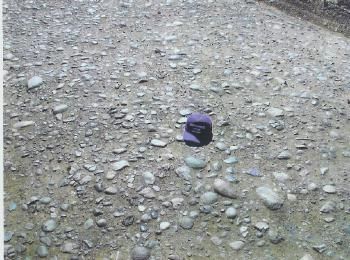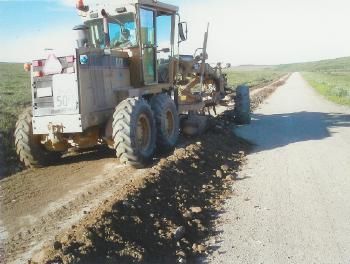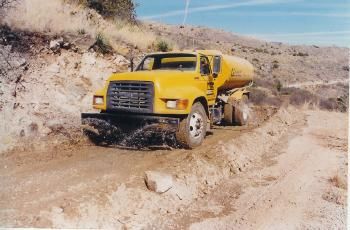
Total Road Solutions - LOW VOLUME ROADS
In this section, we will guide you through the
|
||
|
IDENTIFYING YOUR ROAD PROBLEM(S): It is very difficult to identify a "common road problem" when defining your unique road challenges and it is not realistic to say that all roads are alike. Various factors determine the current condition of any road surface ranging from how you road was originally built, what materials were used, your weather conditions and the various levels of maintenance used to maintain them over the years. Without going into too much detail, here are a few examples of what usually happens to low volume roads, (specifically gravel roads) and what causes them to deteriorate. |
||
|
Many methods of preparing the road surface can be used depending on what's in your road. Loose gravel piles along the side of the road edge and material in the ditches can usually be recovered by using a grader. River rock, large angular rocks and all other types of material (excluding bedrock) can usually be recovered using either a grader equipped with a ripper or a dozer can be used. Bedrock or any other type of fixed rock (anything too large to remove from the road bed) can usually be reduced or lowered using a hydraulic hammer. It is not important to remove all bedrock, only remove material down to 6 inches below where your finished road level will be. You will later overlay the surface with 4 - 6 inches of crushed material. Other road "in-place processing" type machines can be used to remove bedrock but are costly and they are not necessary if you only have occasional spots of bedrock. The FAHR ROADCRUSHER method of crushing allows you to clean out your ditches and return your road to its original width and height as it crushes on the surface. "In-place processing" machines dig into the entire road surface and loosens all material (including the existing stable base) which may be the cause of future water erosion. The FAHR ROADCRUSHERs' patented crushing system can provide a better crushed end product, so don't sacrifice the integrity of your entire road bed just to remove a bit of bedrock. |
||
 |
Picture 8: Windrow prep. This D6 Dozer is assisting the grader operator by pushing the ripped material into a pile along the road. |
|
PREPARING A WINDROW |
||
|
Picture 11: Windrow position
|
||
|
|
||
|
Picture 14: Bring in the crusher! This is the easy part of the whole process. Simply align the crusher over the windrow, lower the skids flat on the road surface and slowly drive the crusher forward over the windrow. The crushers' patented crushing system takes all the material in the windrow and drives it upward where it is crushed against a stationary anvil. From this point on, all the crusher operator has to do is watch he gages and keep an eye on the road level. |
||
 |
In this photo you can see the crushed material. The crusher discharge flap is on the left and the loader tires are at the right. |
|
|
Crushed Material In this photo, you can see that the FAHR ROADCRUSHER has completely recycled the larger rocks that were in the original windrow. The finished material is now an average 2 inch minus* with a good mixture of medium to fine material. This mixture of large to finer aggregate along with the proper moisture content will ensure that the finished road surface compacts well and becomes a stable interlocking structure. |
||
|
|
||
|
(before) This is the same picture as shown before (picture #15), we just wanted to show you the before and after photos. |
||
|
Picture 19: Finish Grading It is important to always grade the crushed material as soon as possible in an effort to maintain the proper moisture in the crushed material. This helps the crushed material compact better and provides a more stable driving surface. |
||
|
|
||
|
Picture 20: A new surface The before photo is picture #3. Notice how the road no longer has large rocks sticking out of the surface and how the pile of rocks along the road edge are gone. It's not wasted, it's back in the roadbed - where it belongs. |
||
|
If you have roads that look like the roads on page one of this section, there is now a solution. A solution that can save you time, money, and having to create new gravel pits. A solution where some of our clients are saving 50% and even 90% over some traditional methods of road maintenance expenses.
Or Call: 1-888-983-7333 (USA), (808) 330-FAHR (3247) (Int'l) |



















 Conclusion:
Conclusion: